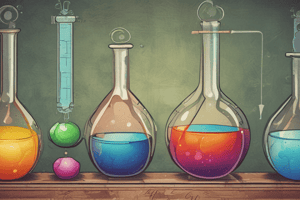Podcast
Questions and Answers
A substance that accepts two protons (H+ ions) in a solution is a base.
A substance that accepts two protons (H+ ions) in a solution is a base.
False (B)
Sulfuric acid (H2SO4) is a weak acid.
Sulfuric acid (H2SO4) is a weak acid.
False (B)
A pH of 9 indicates a highly acidic solution.
A pH of 9 indicates a highly acidic solution.
False (B)
Citric acid (C6H8O7) is a strong acid.
Citric acid (C6H8O7) is a strong acid.
A neutralization reaction produces a salt and oxygen gas.
A neutralization reaction produces a salt and oxygen gas.
Ammonia (NH3) is a strong base.
Ammonia (NH3) is a strong base.
A buffer solution is a solution that changes pH drastically when an acid or base is added.
A buffer solution is a solution that changes pH drastically when an acid or base is added.
Hydrochloric acid (HCl) turns litmus paper blue.
Hydrochloric acid (HCl) turns litmus paper blue.
A pH of 5 indicates a highly basic solution.
A pH of 5 indicates a highly basic solution.
Flashcards are hidden until you start studying
Study Notes
Acids and Bases
Definitions
- Acid: a substance that donates a proton (H+ ion) in a solution
- Base: a substance that accepts a proton (H+ ion) in a solution
Properties of Acids and Bases
- Acid properties:
- Taste sour
- Conduct electricity
- Turn litmus paper red
- React with metals to produce hydrogen gas
- Base properties:
- Taste bitter
- Feel slippery
- Turn litmus paper blue
- React with oils to produce soap
pH Scale
- pH: a measure of the concentration of hydrogen ions (H+) in a solution
- pH range: 0-14, with 7 being neutral (neither acidic nor basic)
- Acidic: pH < 7
- Basic: pH > 7
Strong and Weak Acids and Bases
- Strong acid: completely dissociates in water, releasing all H+ ions
- Examples: hydrochloric acid (HCl), sulfuric acid (H2SO4)
- Weak acid: partially dissociates in water, releasing some H+ ions
- Examples: citric acid (C6H8O7), acetic acid (CH3COOH)
- Strong base: completely dissociates in water, releasing all OH- ions
- Examples: sodium hydroxide (NaOH), calcium hydroxide (Ca(OH)2)
- Weak base: partially dissociates in water, releasing some OH- ions
- Examples: ammonia (NH3), trimethylamine (N(CH3)3)
Acid-Base Reactions
- Neutralization reaction: a reaction between an acid and a base that produces a salt and water
- Example: HCl + NaOH → NaCl + H2O
- Buffer solution: a solution that resists changes in pH when an acid or base is added
- Example: a mixture of acetic acid and sodium acetate
Acids and Bases
Definitions
- Acid: a substance that donates a proton (H+ ion) in a solution
- Base: a substance that accepts a proton (H+ ion) in a solution
Properties
Acid Properties
- Taste sour
- Conduct electricity
- Turn litmus paper red
- React with metals to produce hydrogen gas
Base Properties
- Taste bitter
- Feel slippery
- Turn litmus paper blue
- React with oils to produce soap
pH Scale
- pH: a measure of the concentration of hydrogen ions (H+) in a solution
- pH range: 0-14, with 7 being neutral (neither acidic nor basic)
- Acidic: pH < 7
- Basic: pH > 7
Strong and Weak Acids and Bases
Strong Acids
- Completely dissociate in water, releasing all H+ ions
- Examples: hydrochloric acid (HCl), sulfuric acid (H2SO4)
Weak Acids
- Partially dissociate in water, releasing some H+ ions
- Examples: citric acid (C6H8O7), acetic acid (CH3COOH)
Strong Bases
- Completely dissociate in water, releasing all OH- ions
- Examples: sodium hydroxide (NaOH), calcium hydroxide (Ca(OH)2)
Weak Bases
- Partially dissociate in water, releasing some OH- ions
- Examples: ammonia (NH3), trimethylamine (N(CH3)3)
Acid-Base Reactions
- Neutralization reaction: a reaction between an acid and a base that produces a salt and water
- Example: HCl + NaOH → NaCl + H2O
- Buffer solution: a solution that resists changes in pH when an acid or base is added
- Example: a mixture of acetic acid and sodium acetate
Studying That Suits You
Use AI to generate personalized quizzes and flashcards to suit your learning preferences.




